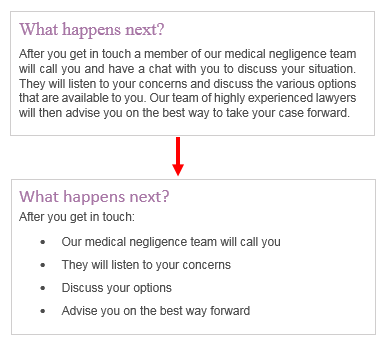The copy on your website is key to providing the content needed for users to make informed decisions about your product or service. But poorly written and formatted content can really impact on your conversion, so here are a few techniques to ensure your website is performing at its best.
As CRO consultant, my role can involve reviewing client’s websites and ensuring their content and copy is as engaging as it can be for prospective users.
Often the copy on your website plays second fiddle to the overall design. The design is often considered key for conversion, creating a website that fits your brand and looks great, while also laid out on the page in a way that encourages users to engage as much as possible. Copy is often taken from existing content that has been refined previously for offline promotions, and simply added to the page to fit with the design.
But user behaviour online can be different than offline, and focusing on the copy and the words used in your website can often be the turning point for converting consumers. Simply changing a single word on a call to action button can have an uplift of 12% in conversion. With this is mind, I tuned into CIM’s webinar, The dos and don’ts of digital content writing. Hosted by Tim Fidgeon, one of the UK’s leading trainers in online writing and user experience, he talked through some of the best practices for writing effective digital content.
Research suggests that on average just 20% of a web page’s content is read, with 70% of users scanning pages to pick out key points before deciding to engage. Testing has shown that there is often a pattern to a user’s reading movement, where focus is stronger in the top-right hand side of the page (known as the F-Shaped Pattern) as scanners quickly pick up the first couple of words of each line to determine its relevance.
Below is my summary of what techniques should be used to ensure your key messages are still clear and acknowledged. I was pleased to see we try and emulate all of these!
Simple vocabulary
Use words that are appropriate for your audience and avoid jargon where possible. The exception to this is when you’re advertising to professionals or a specific audience with a lot of knowledge on the subject area. By creating copy as if you were writing for a user who’s English is a second language, you are more likely to create clear and simple text that is easy to read.
Short sentences and paragraphs
Sentences should be around 15-20 words. if you need to use more than one comma then your sentence might be too long. Guidelines for paragraph length is about four sentences with six lines maximum (for mobile consider making paragraphs even smaller at about 3 lines). Breaking content up like this makes it easier to read.
Stand-out headings
Headings and sub-headings provide a visual signal that a new topic is starting, acting as a road sign for the following section. They should make sense to a user out of context to enable them to determine if the next section is relevant:
- Begin with informative, easy to digest words
- Avoid using question words at the beginning of your heading (‘who’, ‘what’, ‘why’, ‘where’) – it means users won’t get to the important words of your heading straight away
- Don’t use repetition. Especially at the beginning of headings – it makes it harder to read and digest
- Consider formatting – headings stand out more if they are bold and a larger font

Source https://goto.webcasts.com/viewer/event.jsp?ei=1070...
The examples above show that by shortening headings and ensuring the main message is first makes it easier for users to comprehend quickly what the section will be discussing. The fourth example is a good compromise where the first couple of words make sense out of context, but the entire heading provides a good clear summary of what to expect from the paragraph below.
Lists are good
Lists are a great way to break up lengthy copy and can help users find key information really quickly. Here are some tips to consider when turning your copy into lists:
- Use bullet points, it makes it clear it’s a list
- Avoid repetition where you can
- Begin with informative words and get to the point quickly
- Keep them short and sweet
- Aim for three to five items
The example below shows how splitting up a paragraph into bullet points makes it much easier to read:

Content on your website doesn’t have to be minimal, and in fact websites that don’t have enough key information to help the user make decisions can be just as bad as too much. But by using techniques and formatting to break the content up, it will help ensure your main messages stand out visually on the page.
Have a look at your landing page and see if you can follow these easy techniques to making sure your copy is easy to read. Get in touch if you’d like to find out more about how to improve your landing page for conversion.